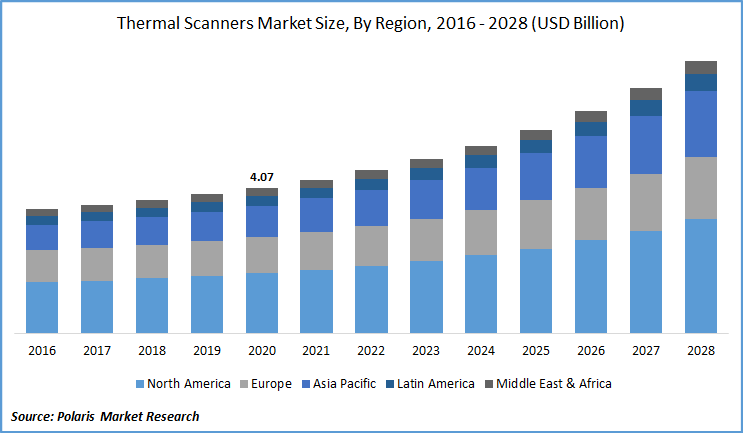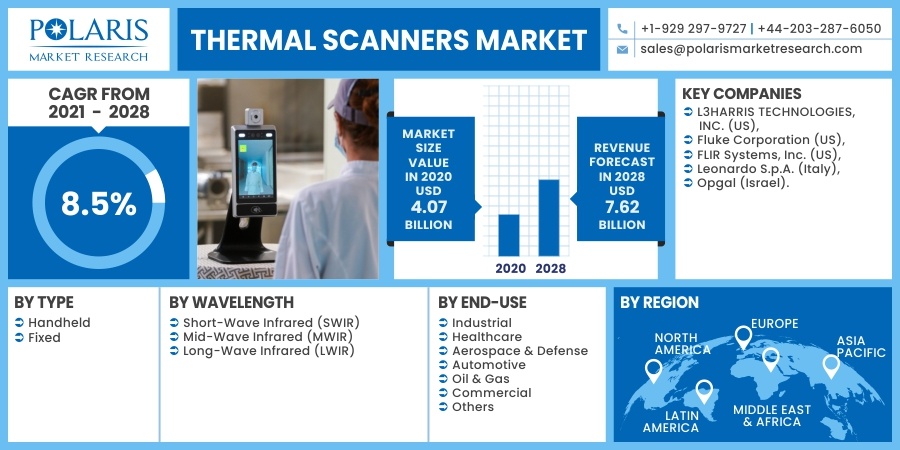
Thermal Scanners Market Size, Share & Trends Analysis Report, By Wavelength (Short-Wave Infrared, Mid-Wave Infrared, Long-Wave Infrared); By End-Use (Industrial, Healthcare, Aerospace & Defense, Automotive, Oil & Gas, Commercial); By Type; By Region, And Segment Forecasts, 2021 - 2028
- Published Date:May-2021
- Pages: 117
- Format: PDF
- Report ID: PM1907
- Base Year: 2020
- Historical Data: 2016 - 2019
Report Outlook
The global thermal scanners market was valued at USD 4.07 billion in 2020 and is expected to grow at a CAGR of 8.5% during the forecast period. The market is being driven by a surge in mass screening of COVID-19 cases and rapid adoption in the defense sector for security and surveillance services. The pandemic has shifted marketing strategies of key players for these goods as potential countermeasures to coronavirus spread.
 Know more about this report: request for sample pages
Know more about this report: request for sample pages
The growing market demand for thermal scanners for n number of screening at colleges, hotels, airports, shopping malls, and theatres, as well as increased adoption of thermal scanners in the aerospace, automotive, and defense sectors, and mounting R&D investments by governments, organizations, and firms to create better thermal scanning solutions, are all contributing to the market's development.
Thermal scanners are expected to see increased usage in the industrial and healthcare sectors, as the market requires cost-effective instruments for non-destructive material testing and improved safety standards.
Industry Dynamics
Growth Drivers
A major factor that is driving the market is the high demand for thermal scanners at airports. The use of these scanners at international airports has been mandated by many governments around the world, which has fueled market growth, which opened a lot of possibilities for the product demand in domestic facilities.
After that, there is a high research & development activity as well as government expenditure on the thermal scanners. Thermal scanners are in high demand in several sectors, including automotive, aerospace, defense, and others.
The market for thermal scanners has been fueled by the adoption of these systems for border control, law enforcement, and structural health monitoring of aircraft applications. They also aid in the quick detection and targeting of enemy forces. Higher expenditure has certainly pushed high demand for adopting advanced equipment, which in turn, driving the market growth for scanners.

Know more about this report: request for sample pages
Thermal Scanners Market Report Scope
The market is primarily segmented on the basis of type, wavelength, end-use, and region.
|
By Type |
By Wavelength |
By End-Use |
By Region |
|
|
|
|
Know more about this report: request for sample pages
Insight by Wavelength
On account of the demand for tracking, inspection, and measurement applications in the automotive, food & beverage, building, and healthcare end-use verticals, the LWIR segment is expected to witness high growth over the forecast period. Furthermore, high-temperature thermography, protection and surveillance, semiconductor inspection, moisture detection, spectroscopy, and scientific research are all contributing to the market's development.
The segment's dominance can be due to the increased demand for this long-wave infrared scanner in automotive industries, civil infrastructure, medical, and monitoring applications. The increased pace is the reason for its increased success in the aforementioned industries.
When compare to mid-wave infrared, the LWIR scanner can offer approx. 12.5 times better snapshot speeds in long-wave infrared. Besides, whenever the scanner is set to long-wave infrared, it offers a wider range of temperature bands. As a result, the advantages related to long-wave infrared thermal scanners add to the segment's market share.
In the upcoming years, the MWIR segment is anticipated to rise at a significant pace. Long-range observation, medical diagnosis, satellite-based weather profile tracking, and deforestation mapping are all common uses for MWIR. The development of dual-color detector designs and HOT MWIR allowed the use of these cameras for a variety of applications that were previously conquered by LWIR cameras.
Insight by End-Use
The demand for thermal scanners in commercial segment is expected to witness the fastest growth over the projected period. The growing focus on restaurants, hotels, Thermography in airports, and malls during the pandemic times has driven high demand for this scanner for commercial purposes, leading to the segment's growth.
Thermal scanners have been widely used at airports since the outbreak of the global pandemic disease coronavirus. As people's understanding of their safety grows, commercial complexes such as malls, and corporate offices are expected to become more common.
For example, Ramco Systems launched improved versions of thermal scanning and facial recognition to detect the temperatures organization’s members who are marking attendance for safety purposes. This has certainly proven to be a great opportunity for the product especially in the transportation and commercial segments.
Geographic Overview
The market demand for thermal scanners is dominated by countries with a high incidence of COVID-19. Demand is currently strong in both North America and Europe. Because of the unbridled increase in COVID-19 incidents, the United States has become a hotspot for thermal scanner sales. Japan, India, and China will continue to be in high demand in the east. China's thermal scanner revenues are exploding.
In the past few years, North America had captured the highest market share of thermal scanners and is predicted to do so during the projected period. With the flourishing defense industry, there are high possibilities of significant growth in the U.S. market. Most prominent players such as Fluke Corporation, L3harris Technologies, Inc., and FLIR Systems, Inc.; have largely contributed to the market growth.
In the future, Asia Pacific thermal scanners market is projected to develop at the fastest pace. China took the lead in terms of revenue in the area. This owes to a higher number of vendors offering cost-effective solutions which are expected to increase market demand in the COVID-19 times.
As a result of the outbreak in China, the market for thermal scanners has skyrocketed, forcing companies to ramp up production. To fight the outbreak, the region is investing in research and development. Subsequently, Wuhan Guide Infrared Co., Ltd. declared that China's public transportation infrastructure would be fitted with these systems driven by AI facial recognition.
Competitive Insight
The global thermal scanners market has some players which are dominating the market such as L3HARRIS TECHNOLOGIES, INC. (US), Fluke Corporation (US), FLIR Systems, Inc. (US), Leonardo S.p.A. (Italy), and Opgal (Israel). To boost their market, these businesses have used both organic and inorganic growth strategies such as product launches and innovations, alliances, deals, contracts, and mergers and acquisitions.
The FLIR RangerHDC MR which offers high-performance HD thermal imaging with the capability of a midrange surveillance system was released in 2020 by FLIR Systems, Inc. Using embedded analytics and image processing, the Ranger HDC MR can detect criminal activity in worsening conditions of weather. On account of this, the company's product range in the thermal imaging device segment is expected to improve.
